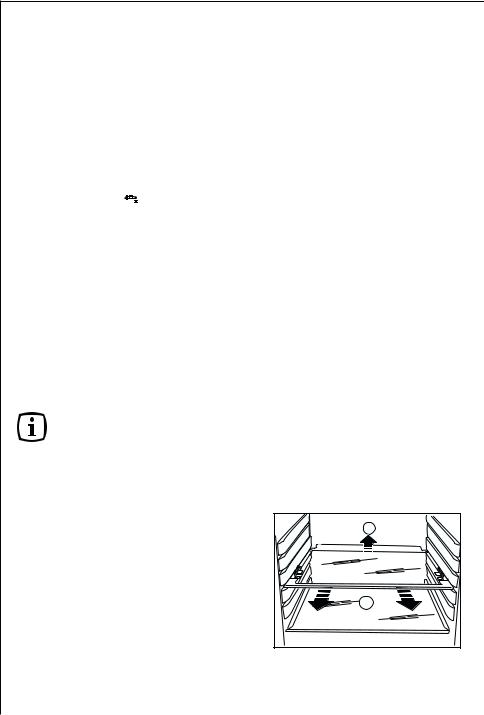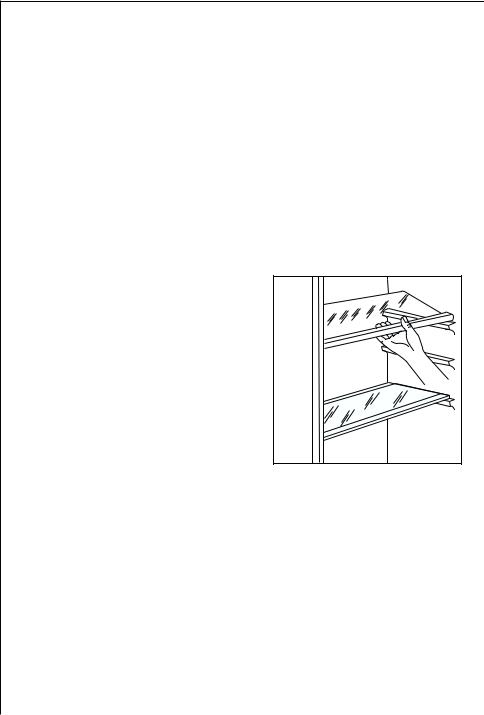Electrolux C 9 18 44-5 i User Manual
SANTO C 9 18 44-5 i
User Manual |
Fridge Freezer |

Dear Customer
Thank you for choosing one of our high-quality products.
With this appliance you will experience the perfect combination of functional design and cutting edge technology.
Convince yourself that our appliances are engineered to deliver the best performance and control - indeed we are setting the highest standards of excellence.
In addition to this you find environmental and energy saving aspects as an integral part of our products.
To ensure optimal and regular performance of your appliance please read this instruction manual carefully. It will enable you to navigate all processes perfectly and most efficiently.
To refer to this manual any time you need to, we recommend you to keep it in a safe place. And please pass it to any future owner of the appliance.
We wish you much joy with your new appliance.
The following symbols are used in this manual
Important information concerning your personal safety and information on how to avoid damaging the appliance
 General information and tips
General information and tips
 Environmental information
Environmental information
2

Contents
Safety . . . . . . . . . . . . . . . . . . . . . . . . . . . . . . . . . . . . . . . . . . . . . . . . . . . . . .4
Disposal . . . . . . . . . . . . . . . . . . . . . . . . . . . . . . . . . . . . . . . . . . . . . . . . . . . .5
Appliance Packaging Information . . . . . . . . . . . . . . . . . . . . . . . . . . . . . .5
Disposal of Old Appliances . . . . . . . . . . . . . . . . . . . . . . . . . . . . . . . . . . . . .5
Remove Transport Packaging . . . . . . . . . . . . . . . . . . . . . . . . . . . . . . . . .6
Shelf Holders . . . . . . . . . . . . . . . . . . . . . . . . . . . . . . . . . . . . . . . . . . . . . . . .6
Operating and Indicator Panel . . . . . . . . . . . . . . . . . . . . . . . . . . . . . . . . .7
Starting Up and Temperature Regulation . . . . . . . . . . . . . . . . . . . . . . .7
Interior Accessories . . . . . . . . . . . . . . . . . . . . . . . . . . . . . . . . . . . . . . . . .8
Storage Shelves . . . . . . . . . . . . . . . . . . . . . . . . . . . . . . . . . . . . . . . . . . . . . .8
Variable Inner Door . . . . . . . . . . . . . . . . . . . . . . . . . . . . . . . . . . . . . . . . . . .8
Variable Storage Box . . . . . . . . . . . . . . . . . . . . . . . . . . . . . . . . . . . . . . . . . .8
Moisture Regulator . . . . . . . . . . . . . . . . . . . . . . . . . . . . . . . . . . . . . . . . . . .9
Fresh Food Refrigeration . . . . . . . . . . . . . . . . . . . . . . . . . . . . . . . . . . . .10
Freezing and Storing Frozen Food . . . . . . . . . . . . . . . . . . . . . . . . . . . . .10
Ice Pack . . . . . . . . . . . . . . . . . . . . . . . . . . . . . . . . . . . . . . . . . . . . . . . . . . . .11
Preparation of Ice Cubes . . . . . . . . . . . . . . . . . . . . . . . . . . . . . . . . . . . .11
Freezing Calendar . . . . . . . . . . . . . . . . . . . . . . . . . . . . . . . . . . . . . . . . . .12
Defrosting . . . . . . . . . . . . . . . . . . . . . . . . . . . . . . . . . . . . . . . . . . . . . . . . .12
Switching Off the Appliance . . . . . . . . . . . . . . . . . . . . . . . . . . . . . . . .13
Cleaning and Care . . . . . . . . . . . . . . . . . . . . . . . . . . . . . . . . . . . . . . . . . .13
Energy Saving Tips . . . . . . . . . . . . . . . . . . . . . . . . . . . . . . . . . . . . . . . . .14
Something Not Working . . . . . . . . . . . . . . . . . . . . . . . . . . . . . . . . . . . . .14
Changing the Light Bulb . . . . . . . . . . . . . . . . . . . . . . . . . . . . . . . . . . . . .16
Service and Spare Parts . . . . . . . . . . . . . . . . . . . . . . . . . . . . . . . . . . . . . .17
Guarantee Conditions . . . . . . . . . . . . . . . . . . . . . . . . . . . . . . . . . . . . . . .18
Installation . . . . . . . . . . . . . . . . . . . . . . . . . . . . . . . . . . . . . . . . . . . . . . . .19
Electrical Connection . . . . . . . . . . . . . . . . . . . . . . . . . . . . . . . . . . . . . . . .19
Positioning . . . . . . . . . . . . . . . . . . . . . . . . . . . . . . . . . . . . . . . . . . . . . . . . .20
Your Appliance Needs Air . . . . . . . . . . . . . . . . . . . . . . . . . . . . . . . . . . . . .20
Housing Dimensions . . . . . . . . . . . . . . . . . . . . . . . . . . . . . . . . . . . . . . . . .20
Regulations, Standards, Guidelines . . . . . . . . . . . . . . . . . . . . . . . . . . . .21
3

 Safety
Safety
Please read this instruction book before using the appliance and retain for future reference. These warnings are provided in the interests of your safety, ensure you understand them fully before using the appliance.
Intended Use
•The appliance is intended for use in the home. It is suitable for the cooling, freezing and storing of frozen food, as well as for making ice. If the appliance is used for purposes other than those intended or used incorrectly, no liability can be accepted by the manufacturer for any damage that may be caused.
•Alterations or changes to the appliance are not permitted for reasons of safety.
Prior to Initial Start–Up
•Check the appliance for transport damage. Under no circumstance should a damaged appliance be plugged in! In the event of damage, please contact your retailer.
Refrigerant
The refrigerant isobutane (R600a) is contained within the refrigerant circuit of the appliance, a natural gas with a high level of environmental compatibility, which is nevertheless flammable.
•During transportation and installation of the appliance, be certain that none of the components of the refrigerant circuit become damaged.
•If the refrigerant circuit should become damaged:
–avoid open flames and sources of ignition;
–thoroughly ventilate the room in which the appliance is situated.
Safety of Children
•Keep packaging material away from children.
•Please make old appliances unusable prior to disposal. Pull out the mains plug, cut off the mains cable and remove any locks or catches, to prevent young children being trapped inside.
•TThis appliance is not intended for use by persons (including children) with reduced physical, sensory or mental capabilities, or lack of experience and knowledge, unless they have been given supervision or instruction concerning use of the appliance by a person responsible for their safety. Chil-
dren should be supervised to ensure that they do not play with the 4 appliance.

Daily Operation
•Do not operate any electrical appliances in the refrigerator/freezer (e.g. electric ice cream makers, mixers etc.).
•Before cleaning the appliance, always switch off the appliance and disconnect from the electricity supply.
•When unplugging always pull the plug from the mains socket, do not pull on the cable.
Service
•Under no circumstances should you attempt to repair the appliance yourself. Repairs carried out by inexperienced persons may cause injury or serious malfunctioning. Contact your local AEG Service Force Centre.
Disposal
Appliance Packaging Information
All materials are environmentally sound.
The plastics can be recycled and are identified as follows:
>PE< for polyethylene, e.g. the outer covering and the bags in the interior.
>PS< for polystyrene foam, e.g. the pads, which are all free of chlorofluorocarbon.
The carton parts are made from recycled paper and should be disposed of at a waste-paper recycling collection location.
5

Disposal of Old Appliances
For environmental reasons, refrigeration appliances must be disposed of properly. This applies to your old appliance, and - at the end of its service life - to your new appliance as well.
Warning! Before disposing of old appliances make them inoperable. Remove plug from mains, sever the power cable, remove or destroy any snap or latch closures, to prevent small children being trapped inside.
• Use an authorised disposal site.
Contact your Local Council or Environmental Health Office to see if there are facilities in your area to recycle the appliance.
The symbol  on the product or on its packaging indicates that this product may not be treated as household waste. Instead it shall be handed over to the applicable collection point for the recycling of electrical and electronic equipment. By ensuring this product is disposed of correctly, you will help prevent potential negative consequences for the environment and human health, which could otherwise be caused by inappropriate waste handling of this product. For more detailed information about recycling of this product, please contact your local city office, your household waste disposal service or the shop where you purchased the product.
on the product or on its packaging indicates that this product may not be treated as household waste. Instead it shall be handed over to the applicable collection point for the recycling of electrical and electronic equipment. By ensuring this product is disposed of correctly, you will help prevent potential negative consequences for the environment and human health, which could otherwise be caused by inappropriate waste handling of this product. For more detailed information about recycling of this product, please contact your local city office, your household waste disposal service or the shop where you purchased the product.
Remove Transport Packaging
The appliance and the interior fittings are protected for transport.
•Remove all adhesive tape and packing pieces from the interior of the appliance.
Shelf holders
Your appliance is equipped with shelf retainers that make it possible to secure the shelves during transportation.
To remove them proceed as follows: Raise the shelf from the back, push it in the direction of the arrow until it is freed and remove the retainers.
A |
B |
6

Operating and Indicator Panel
A B C D
A.Light button
B.Pilot light fast-freeze
C.Fast freeze button
D.Temperature control knob and ON/OFF switch
The temperature control knob (D), which is also the appliance’s On-/Off switch.
The yellow pilot light (B) comes on when the fast freezing button (C) has been operated. The refrigerating unit then operates continuously.
Important note: if you operate the fast-freeze switch or adjust the temperature control knob, the motor might not start immediately. This does not mean that your appliance has a fault.
Starting Up and Temperature Regulation
Wash the inside of the appliance with lukewarm water with a little bicarbonate of soda added (5ml to 0,5 litre of water). Do not use soap or detergent as the smell may linger. Dry the appliance thoroughly.
•Turn the temperature control knob (D) in the direction of “1“.
•Operate the fast-freeze button (C). The yellow pilot lamp (B) comes on.
Setting “•”: Off.
Setting “1”: Hightest temperature, (warmest setting).
Setting “4” (end-stop) : Lowest temperature, (coldest setting).
The exact setting should be chosen keeping in mind that the temperature inside the refrigerator depends on:
-the quantity of food stored -how often the door is opened
The temperatures in the refrigerator compartment and freezer compartment cannot be independently regulated.
7

If you want to freeze fresh food rapidly, select setting “4”, ensuring that the temperature in the refrigerator compartment does not drop below 0°C. You should reset the temperature control knob to setting “2” or “3”, if this does occur.
As soon as the fresh food placed in the freezer has frozen, return the temperature control knob to “2” or “3”.
Important!
High ambient temperatures (e.g. on hot summer days) and a cold setting on the temperature regulator (position"3" to "4") can cause the compressor to run continuously.
If this happens, turn the temperature regulator back to a warmer setting (position "2" to "3"). At this setting the compressor will be switched on and off as usual and automatic defrosting recommenced.
Interior Accessories
Storage Shelves
The glass shelf above the fruit and vegetable compartment should always remain in position, to ensure fruit and vegetables stay fresh longer.
The remaining storage shelves can be adjusted to various heights:
Pull the storage shelf forward until it
can be tipped up or down and remo- D338 ved.
To insert at a different height use the same procedure in reverse. Adjustment for tall goods:
Remove the front half of the two-part vario glass storage shelf and insert it at a different level. Space is thus gained for storage of tall goods on the underlying storage shelf.
Variable Inner Door
The door compartments can be pulled up and removed, and inserted at other positions as needed.
Variable Storage Box
Some models are equipped with a variable storage box which is fitted under a door shelf compartment and can be slid sideways.
8
